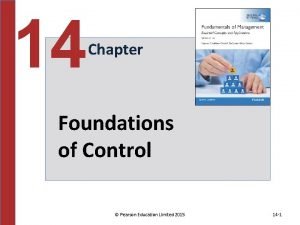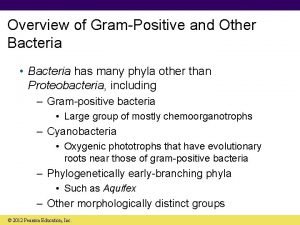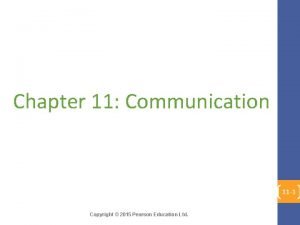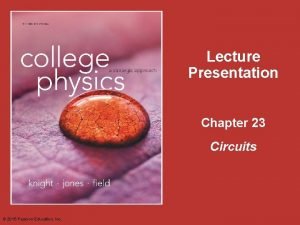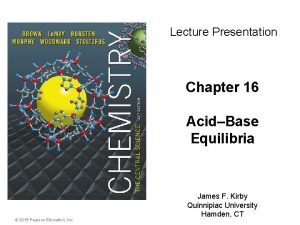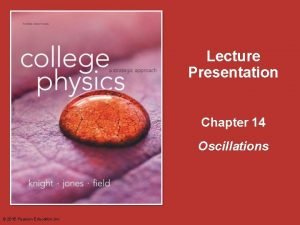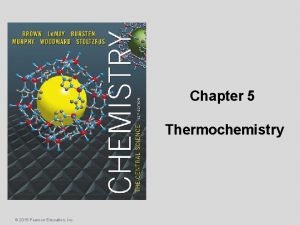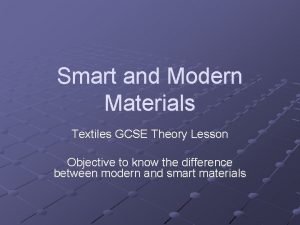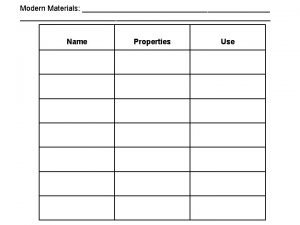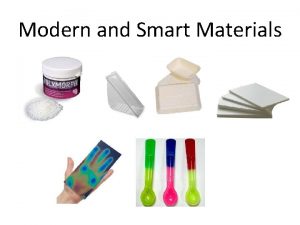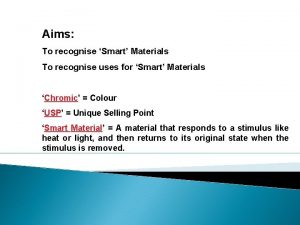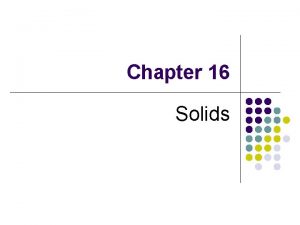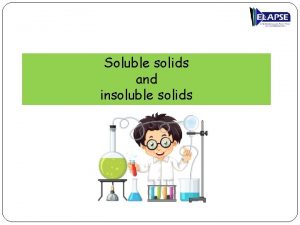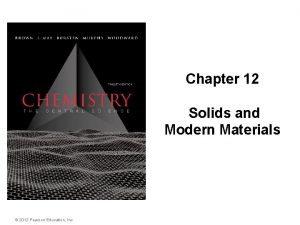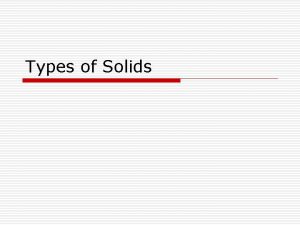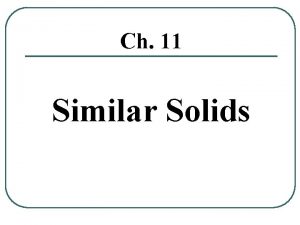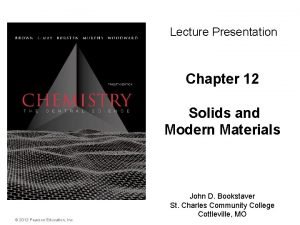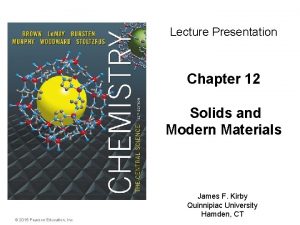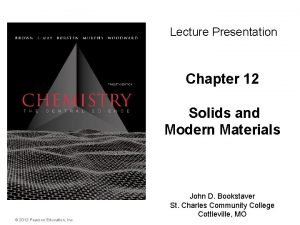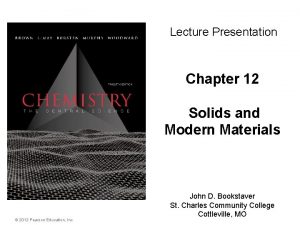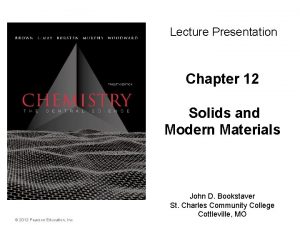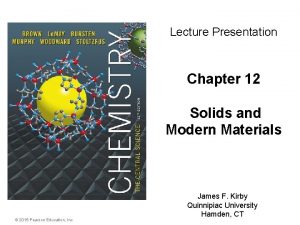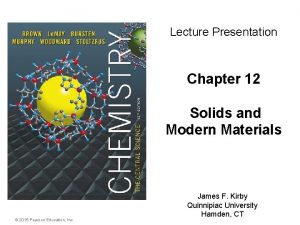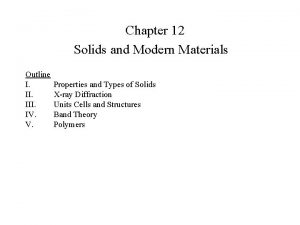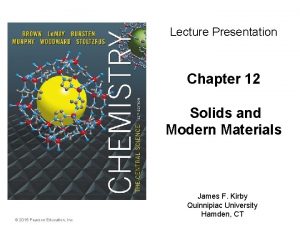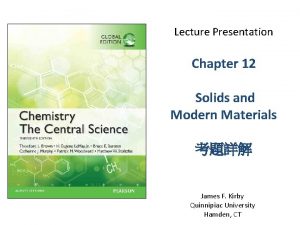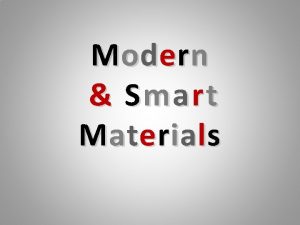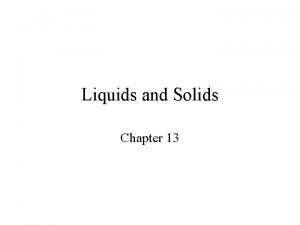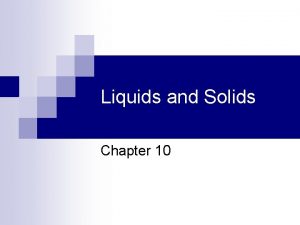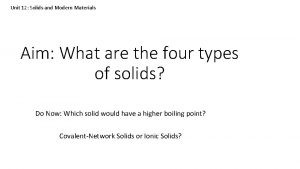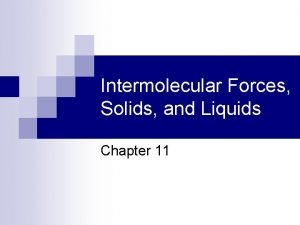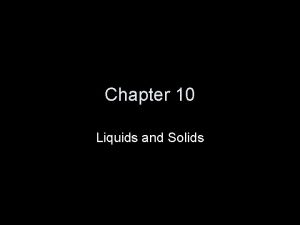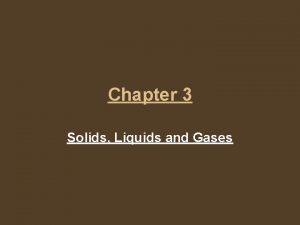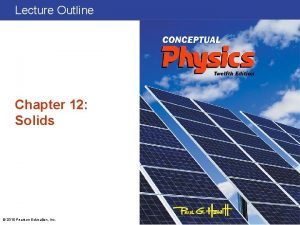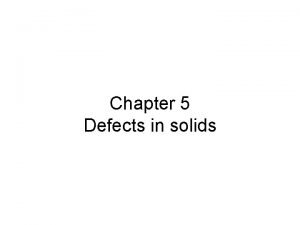Chapter 12 Solids and Modern Materials 2015 Pearson






































- Slides: 38

Chapter 12 Solids and Modern Materials © 2015 Pearson Education, Inc.

Classification of Solids • Metallic Solids – Held together by a “sea” of collectively shared electrons. • Ionic Solids – Sets of cations and anions mutually attracted to one another. • Covalent-network Solids – Joined by an extensive network of covalent bonds. • Molecular Solids – Discrete molecules held together by weak forces. © 2015 Pearson Education, Inc.

Classification of Solids • Polymers – Long chains of atoms connected by covalent bonds – Chains can be connected to other chains by weak forces. – Different properties than small molecules or metallic or ionic compounds. • Nanomaterials – Crystalline compounds with the crystals on the order of 1– 100 nm – Very different properties than larger crystalline materials. © 2015 Pearson Education, Inc.

Structures of Solids • Crystalline Solids – Solids with a regular repeating pattern of atoms • Amorphous Solids – Characterized by a distinct lack of order in the arrangement of atoms © 2015 Pearson Education, Inc.

Structures of Solids • Unit Cell – The basis of a repeating pattern • The structure of a crystalline solid is defined by – the size and shape of the unit cell. – the locations of atoms within the unit cell. © 2015 Pearson Education, Inc.

Structures of Solids • Lattice Points – Positions that define the overall structure of the crystalline compound • Lattice Vectors – Connect the points and define the unit cell. 2 -D Lattices © 2015 Pearson Education, Inc.

Structures of Solids 3 -D Lattices © 2015 Pearson Education, Inc.

Structures of Solids • Primitive Lattices – Atoms only in the lattice points. • Centered Lattices – Atoms in another regular location • Body-Center • Face-Center © 2015 Pearson Education, Inc.

Structures of Solids • Motif – Atoms are not on the lattice points but the overall structure follows a particular unit cell. © 2015 Pearson Education, Inc.

Metallic Solids • The structures of many metals conform to one of the cubic unit cells: simple cubic, body-centered cubic, or face-centered cubic. © 2015 Pearson Education, Inc.

Metallic Solids • Not every part of an atom on a lattice point is completely within that unit cell. One can determine how many atoms are within each unit cell. • Eight cubes meet at a corner, therefore only 1/8 of that corner atom is within any one unit cell meeting there. • Two cubes meet at a face, therefore only 1/2 of that face atom is within any one unit cell meeting there. • A body-centered atom is entirely within the unit cell. © 2015 Pearson Education, Inc.

Metallic Solids • Nature does not like empty space! • The atoms in a crystal pack as close together as they can. • The two common types of packing – cubic close-packed. – hexagonal close-packed © 2015 Pearson Education, Inc.

Metallic Solids • Packing Efficiency – A face-centered cubic metal has 4 atoms / unit cell. © 2015 Pearson Education, Inc.

Metallic Solids • Packing Efficiency – What is the packing efficiency of a body-centered cubic metal? – 2 atoms / unit cell. © 2015 Pearson Education, Inc.

Metallic Solids • Alloys – Materials that contain more than one element and have the characteristic properties of metals. – It is an important means employed to change the properties of certain metals. © 2015 Pearson Education, Inc.

Metallic Solids • Substitutional alloys – A second element takes the place of a metal atom. • Interstitial alloys – A second element fills a space in the lattice of metal atoms. • Heterogeneous alloys – Components not dispersed uniformly © 2015 Pearson Education, Inc.

Metallic Solids • Intermetallic Compounds – Distinct properties, definite composition (since they are compounds) – Ordered, rather than randomly distributed © 2015 Pearson Education, Inc.

Metallic Bonding • Electron-Sea Model – Think of a metal as a group of cations suspended in a sea of electrons. – The electrical and thermal conductivity, ductility, and malleability of metals is explained by this model. © 2015 Pearson Education, Inc.

Metallic Bonding • Molecular-Orbital Model – As the number of atoms in a chain increases, the energy gap between the bonding orbitals and between the antibonding orbitals disappears, resulting in a continuous band of energy. Molecular-Orbital Approach (S Orbitals) © 2015 Pearson Education, Inc.

Metallic Bonding • Most metals have d and p orbitals to consider. • Their MO diagrams lead to more bands that better explain conductivity and other properties of metals. Molecular-Orbital Approach (d & p Orbitals) © 2015 Pearson Education, Inc.

Ionic Solids • Lattice comprises alternately charged ions. • High Melting Points • High Boiling Points • Faceting of crystals. © 2015 Pearson Education, Inc.

Ionic Solids • Cation–Anion distances as close as possible • Anion–Anion / Cation–Cation distances maximized. • Three common structures for 1: 1 salts: – Cs. Cl structure – Na. Cl (rock salt) structure – Zinc blend (Zn. S) structure © 2015 Pearson Education, Inc.

Ionic Solids • The size of the cation compared to the anion (radius ratio) is the major factor in which structure is seen for ionic compounds. © 2015 Pearson Education, Inc.

Molecular Solids • Atoms or molecules held together by weaker forces (dispersion, dipole–dipole, or hydrogen bonds). • Shape (ability to stack) matters for some physical properties, like boiling point. • Graphite is an example. © 2015 Pearson Education, Inc.

Covalent-Network Solids • Atoms are covalently bonded over large network distances with regular patterns of atoms. • Tend to have higher melting and boiling points. • Diamond is an example. © 2015 Pearson Education, Inc.

Covalent-Network Solids Semiconductors • They have a gap between the occupied MOs (valence band) and the unoccupied ones (conduction band). • Electrons must enter the conduction band for electron transfer. • Group IVA elements have gaps between the bands of 0. 08 to 3. 05 e. V (7 to 300 k. J/mol). Note: Band gaps over 3. 5 e. V lead to the material being an insulator. © 2015 Pearson Education, Inc.

Covalent-Network Solids Semiconductors • Only Group IVA, all of which have 4 valence electrons, are semiconductors. • Inorganic semiconductors (like Ga. As) tend to have an average of 4 valence electrons (3 for Ga, 5 for As). © 2015 Pearson Education, Inc.

Covalent-Network Solids Semiconductors • Doping – changing the conductivity of semiconductors by adding an element with more or fewer electrons • n-type semiconductors – Have more electrons, so the negative charge travels in the conductance band. • p-type semiconductors – Have fewer electrons, so the “hole” travels in the valence band. © 2015 Pearson Education, Inc.

Polymers • Polymers – Molecules of high molecular weight made by joining smaller molecules, called monomers. • Addition polymers – Formed when a bond breaks, and the electrons in that bond make two new bonds. • Condensation polymers – Formed when a small molecule is removed between two large molecules. © 2015 Pearson Education, Inc.

Polymers © 2015 Pearson Education, Inc.

Polymers © 2015 Pearson Education, Inc.

Polymers © 2015 Pearson Education, Inc.

Polymers • The molecules are not straight lines—the longer the chain, the more twisting happens. • Chains can have a variety of lengths, and therefore a variety of molecular weights. • The material can be very flexible (plastics). • Short range order can lead to crystallinity in the solid. © 2015 Pearson Education, Inc.

Polymers • Chemically bonding chains of polymers to each other can stiffen and strengthen the substance. • Vulcanization – Chains are cross-linked by short chains of sulfur atoms, making rubber stronger. © 2015 Pearson Education, Inc.

Nanomaterials • Particles that have three dimensions on the 1– 100 nm size • Their properties are the study of many labs around the world. © 2015 Pearson Education, Inc.

Nanomaterials • Nanoscale Semiconductors – Small molecules have discrete orbitals; macroscale materials have bands. Where does it switch over? – Theory tells us 1– 10 nm (about 10– 100 atoms). – Quantum dots © 2015 Pearson Education, Inc.

Nanomaterials • Nanoscale Metals – Finely divided metals can have quite different properties than larger samples of metals. © 2015 Pearson Education, Inc.

Nanomaterials • Nanoscale Carbon – Carbon nanotubes can be made with metallic or semiconducting properties without doping. – They are very strong materials. – Graphene has been discovered: single layers with the structure of graphite. © 2015 Pearson Education, Inc.
 2015 pearson education inc
2015 pearson education inc Copyright pearson education inc
Copyright pearson education inc Pearson education limited 2015
Pearson education limited 2015 Foundations of planning
Foundations of planning 2015 pearson education inc
2015 pearson education inc 2015 pearson education inc
2015 pearson education inc Pearson education limited 2015
Pearson education limited 2015 Pearson education limited 2015
Pearson education limited 2015 Pearson education limited 2015
Pearson education limited 2015 Pearson education limited 2015
Pearson education limited 2015 2015 pearson education inc
2015 pearson education inc Pearson education limited 2015
Pearson education limited 2015 Pearson 2015
Pearson 2015 2015 pearson education inc
2015 pearson education inc Pearson education ltd 2015
Pearson education ltd 2015 2015 pearson education inc
2015 pearson education inc Pearson education limited 2015
Pearson education limited 2015 Pearson education limited 2015
Pearson education limited 2015 Pearson 2015
Pearson 2015 Percent ionization
Percent ionization Pearson 2015
Pearson 2015 2015 pearson education inc
2015 pearson education inc 2015 pearson education inc
2015 pearson education inc Favourite cars
Favourite cars Useful and harmful materials found at home
Useful and harmful materials found at home Natural materials and man made materials
Natural materials and man made materials What is adopting materials
What is adopting materials Pearson education, inc. publishing as prentice hall
Pearson education, inc. publishing as prentice hall Pearson education inc publishing as pearson prentice hall
Pearson education inc publishing as pearson prentice hall Bob whelan pearson
Bob whelan pearson Stress management for life 5th edition
Stress management for life 5th edition Pearson education inc publishing as pearson prentice hall
Pearson education inc publishing as pearson prentice hall Pearson 2012
Pearson 2012 2008 pearson prentice hall inc
2008 pearson prentice hall inc Effects of light on smart and modern materials
Effects of light on smart and modern materials Difference between smart and modern materials
Difference between smart and modern materials Name the machine which is smart and modern
Name the machine which is smart and modern Modern and smart materials
Modern and smart materials What is the difference between smart and modern materials
What is the difference between smart and modern materials








